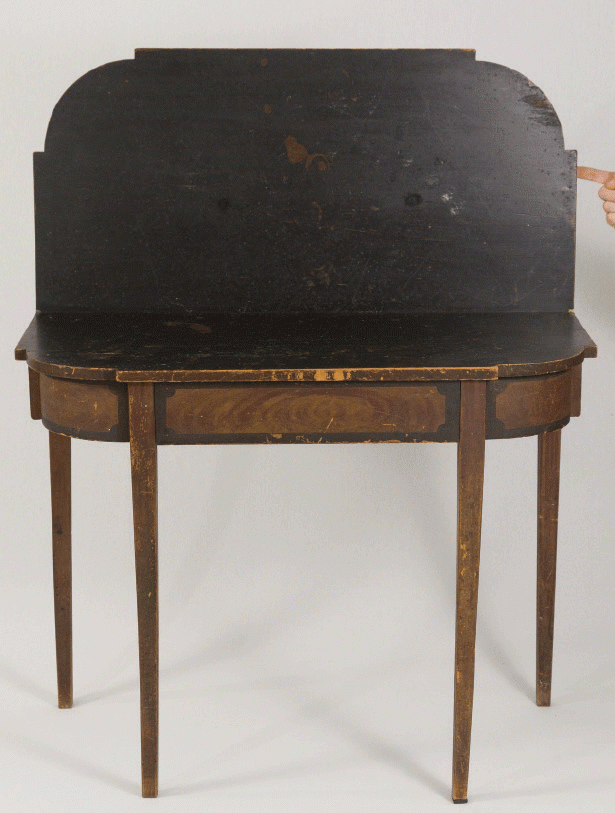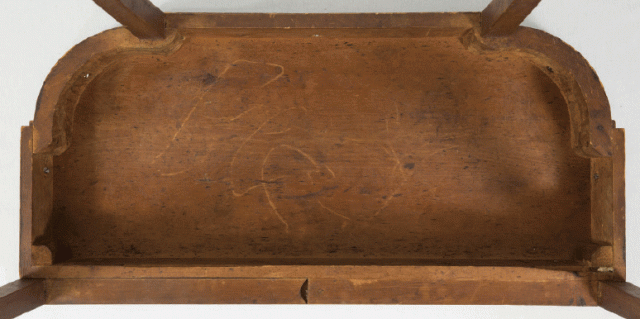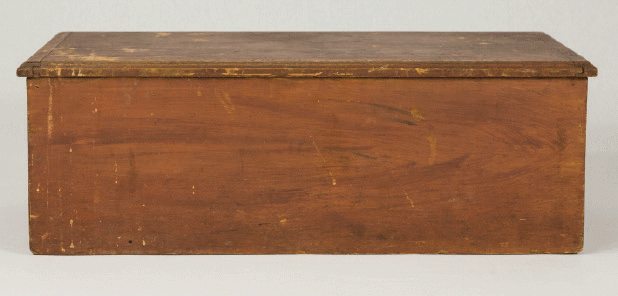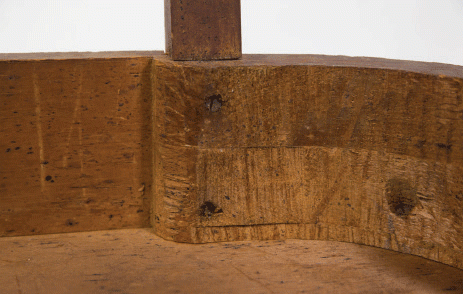
This is an excerpt from “Hands Employed Aright: The Furniture Making of Jonathan Fisher (1768-1847)” by Joshua A. Klein.
The grain-painted card table was a surprising new acquisition donated by a descendant of a Blue Hill family. The donor’s family understands that Fisher made the table for her ancestors, Lucy Stetson and William Wardwell, as a wedding gift in the 1830s. While Fisher’s production (or at least the journal’s record of it) had dramatically slowed by that point, it is, of course, possible that he made this piece.

The construction and graining is consistent with Fisher’s work, but because there are no other card tables attributed to him, no comparisons can be made. Based on the quantitative analysis of Federal period card tables by Benjamin Hewitt, this table could be safely given a northern New England attribution. The construction of the hinged “fly” rail, the square top with ovolo corners, and the horizontal laminations of ovolo corners suggest this may well have been made in Maine. Because Hewitt’s research does not include any documented Maine card tables, this determination is based on the proximity (both geographically and culturally) to Massachusetts.

The construction of the ovolo corners were approached in many different ways, but Fisher might have learned the horizontal lamination method by examining a card table that is now in the museum’s collection during one of his many visits to parishioners’ houses.
The grain painting is much less realistic and more stylized than the wardrobe’s panels, but it is similar to the majority of his graining, such as is seen on his boxes. The paint, although originally bold in color, definitely has a New England plainness about it. One scholar has described Maine’s grain painting as “less flamboyant than that of Pennsylvania and New York State productions [and] usually has a reserved, northern air.”

Although Fisher never mentioned card tables in his journals, he does write about card playing several times. As a conservative Congregationalist, Fisher took gambling to be a serious sin. The Puritan warnings about squandering your resources and the danger of covetousness made a deep impact on his mind. Fisher recalled one occasion as a child when neighbor boys brought a pack of playing cards over for the evening, “the use of which was then forbidden by law. They played a little, and I attempted to play with them.” Although they tried to hide the cards in the morning, his uncle found them out. “He took me aside, questioned me seriously upon the subject, discoursed to me in a mild manner concerning the pernicious effects of gaming, and cautioned me to avoid it. When he had done, it was not my formal promise, but my secret determination never to take cards in hand to play with them again; and through preventing goodness to this day, I have never done it, and hope I never shall.” Fisher then credited “the interposition of Providence” for having “prevented [his] temporal and spiritual ruin.” This event had such a deep impact on him that he seized the opportunity to do the same for a group of children later in his life. It was when he and his family failed to reach their departing ship that the opportunity arose. Fisher recorded, “…[Our] wheelbarrow… on the way broke down and so delayed us that the vessel had hauled off before we could get our chests on board. My sons took a boat and conveyed them on board. By means of these embarrassments I was led to enter in the evening the cabin of a vessel at the wharf, where I found a circle of youths playing cards and gave them a calm, serious lecture upon the subject. The opportunity for this more than compensates for the embarrassment. Wonderful are the ways of Providence!”

Regardless of Fisher’s views on card playing, this furniture form was likely used for more than just games. Gerald Ward has noted how these tables were portable, versatile and inexpensive, and also functioned as “important elements of decoration … in the Federal domestic interior.”
— Meghan B.